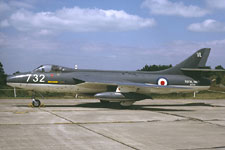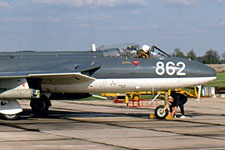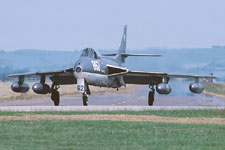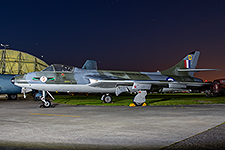 |
| HAWKER HUNTER GA.11 WV256 - '862' |
| WV256's service history
Hunter WV256 was built by Hawker Aircraft Ltd. at its Kingston-upon-Thames factory. It took its first flight on 5th May 1955 with Duncan Simpson at the controls. Following the necessary flight tests, the aeroplane was delivered to the RAF just over two weeks later on 20th May. Its first squadron posting was with RAF 26(F) Sqn based at RAF Oldenburg in West Germany as 'D', and it was later returned to the UK following an assignment to 229OCU (Operational Conversion Unit) at RAF Chivenor. It ended its RAF career being used for training duties in Devon, until it was placed in store in 1961. Transferred to the Royal Navy, Hawker Aircraft Ltd overhauled and converted WV256 to GA.11 specification under contract. It was handed over to the Fleet Air Arm at RNAS Lossiemouth on 2nd April 1963, where it was prepared for entry into service. Its first posting was confirmed on 10th April 1963, when it was moved onto the strength of 738NAS (Navy Air Squadron) as aeroplane '650' with an 'LM' shore code applied on the tail fin. The Squadron moved to RNAS Brawdy in December 1963, and WV256 went with it remaining in use as aeroplane '650 and then later '790' until February 1966, when it was transferred to 764NAS at RNAS Lossiemouth. Now re-issued with the Squadron fleet number '691' and 'LM' shore code on the tail fin, WV256 remained in service for eight months, when it was sent to 5MU (Maintenance Unit) for maintenance work during October. On 3rd May 1967 WV256 was returned to 738NAS at Brawdy, this time as '794' and remained in service with the Unit until November 1971. Following further maintenance at 5MU, WV256 was re-issued back to 764NAS as '695' on 24th May 1972, but this was soon changed to '698'. Just two months later, the aeroplane was put into store at Kemble. On 15th November 1972, WV256 joined Airwork's Air Direction Training Unit (ADTU) at RNAS Yeovilton, initially as '698' but this was soon changed to '732'. |
 [© Richard Vandervord]  [© Robin A. Walker]  [© Martin Morley] | ||
|
|||
| | |||
WV256's civilian life WV256 was originally entered into the July 1995 Philips auction, but it was withdrawn from sale due to complications with its ownership, having received funding from the United States when it was manufactured. This issue was resolved in 2000 and WV256 was entered into the MoD aircraft auction held at Phillips in London during November. Subsequently placed in store at Exeter, the aeroplane was moved by road to Kemble during 2006, and it was assessed for restoration back to flying condition by Delta Jets. However, the plan did not proceed and following a period of store at Kemble WV256 was dismantled by Historic Aero Services and moved by road to Coventry Airport to join Air Atlantique's Airbase museum project as a static exhibit in May 2010. In mid-2012, plans were announced to move the Airbase exhibits to a new home at the former RAF St Mawgan airfield in Cornwall. Between July and August 2014 WV256 was repainted in its former RAF 26 Sqn markings, when in service at RAF Oldenburg, and is on display at the Cornwall Aviation Heritage Centre today. - December 2020 Links |
 [© Mike Hall]  [© Mark Stevens] | ||
| | |||
| << Previous airframe | Next airframe >> |